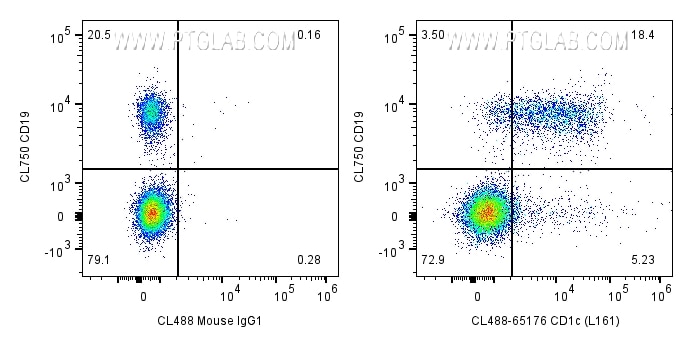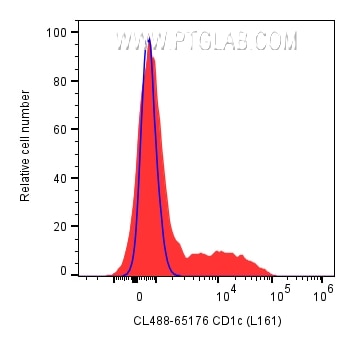Tested Applications
| Positive FC detected in | human PBMCs |
Recommended dilution
| Application | Dilution |
|---|---|
| Flow Cytometry (FC) | FC : 5 ul per 10^6 cells in 100 μl suspension |
| This reagent has been pre-titrated and tested for flow cytometric analysis. The suggested use of this reagent is 5 μl per 10^6 cells in a 100 µl suspension or 5 μl per 100 µl of whole blood. | |
| Sample-dependent, Check data in validation data gallery. | |
Product Information
CL488-65176 targets CD1c in FC applications and shows reactivity with human samples.
| Tested Reactivity | human |
| Host / Isotype | Mouse / IgG1, kappa |
| Class | Monoclonal |
| Type | Antibody |
| Immunogen |
human thymocytes Predict reactive species |
| Full Name | CD1c molecule |
| GenBank Accession Number | BC126465 |
| Gene Symbol | CD1C |
| Gene ID (NCBI) | 911 |
| RRID | AB_3672870 |
| Conjugate | CoraLite® Plus 488 Fluorescent Dye |
| Excitation/Emission Maxima Wavelengths | 493 nm / 522 nm |
| Form | Liquid |
| Purification Method | Affinity purification |
| UNIPROT ID | P29017 |
| Storage Buffer | PBS with 0.09% sodium azide and 0.5% BSA, pH 7.3. |
| Storage Conditions | Store at 2-8°C. Avoid exposure to light. Stable for one year after shipment. |
Background Information
CD1c molecule (CD1c, also known as R7, CD1, CD1A, and BDCA1) is a member of the CD1 family of transmembrane glycoproteins, which is synthesized in the endoplasmic reticulum and expressed on the monocytes, marginal zone B cells in lymph nodes as well as peripheral blood (PMID: 23468110). The CD1 proteins belong to the family of major histocompatibility complex (MHC) class I-like proteins that present lipid-based antigens to T cells (PMID: 15032598; 23127489). CD1c shows interaction with both αβ or γδ T cells and mediates T cell responses against mycobacterium tuberculosis (PMID: 10727456; 10786796).
Protocols
| Product Specific Protocols | |
|---|---|
| FC protocol for CL Plus 488 CD1c antibody CL488-65176 | Download protocol |
| Standard Protocols | |
|---|---|
| Click here to view our Standard Protocols |






